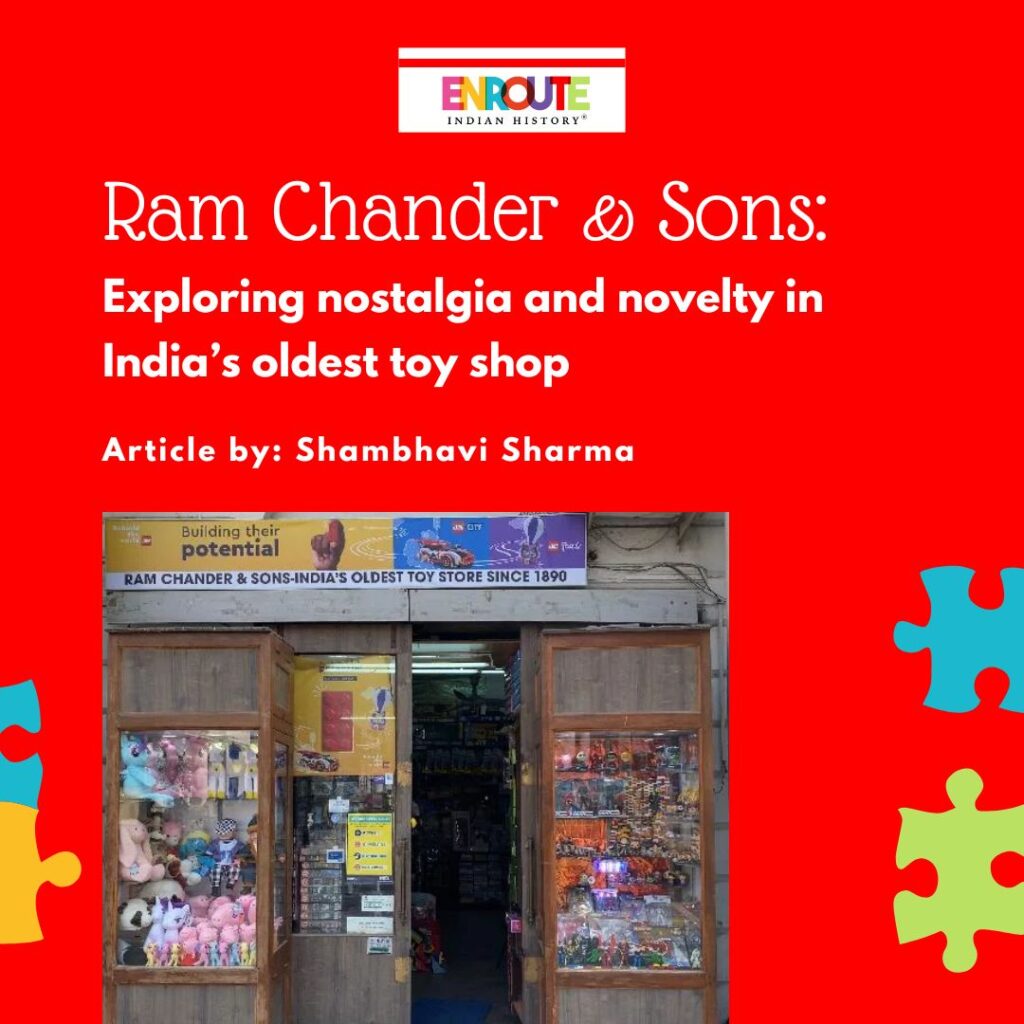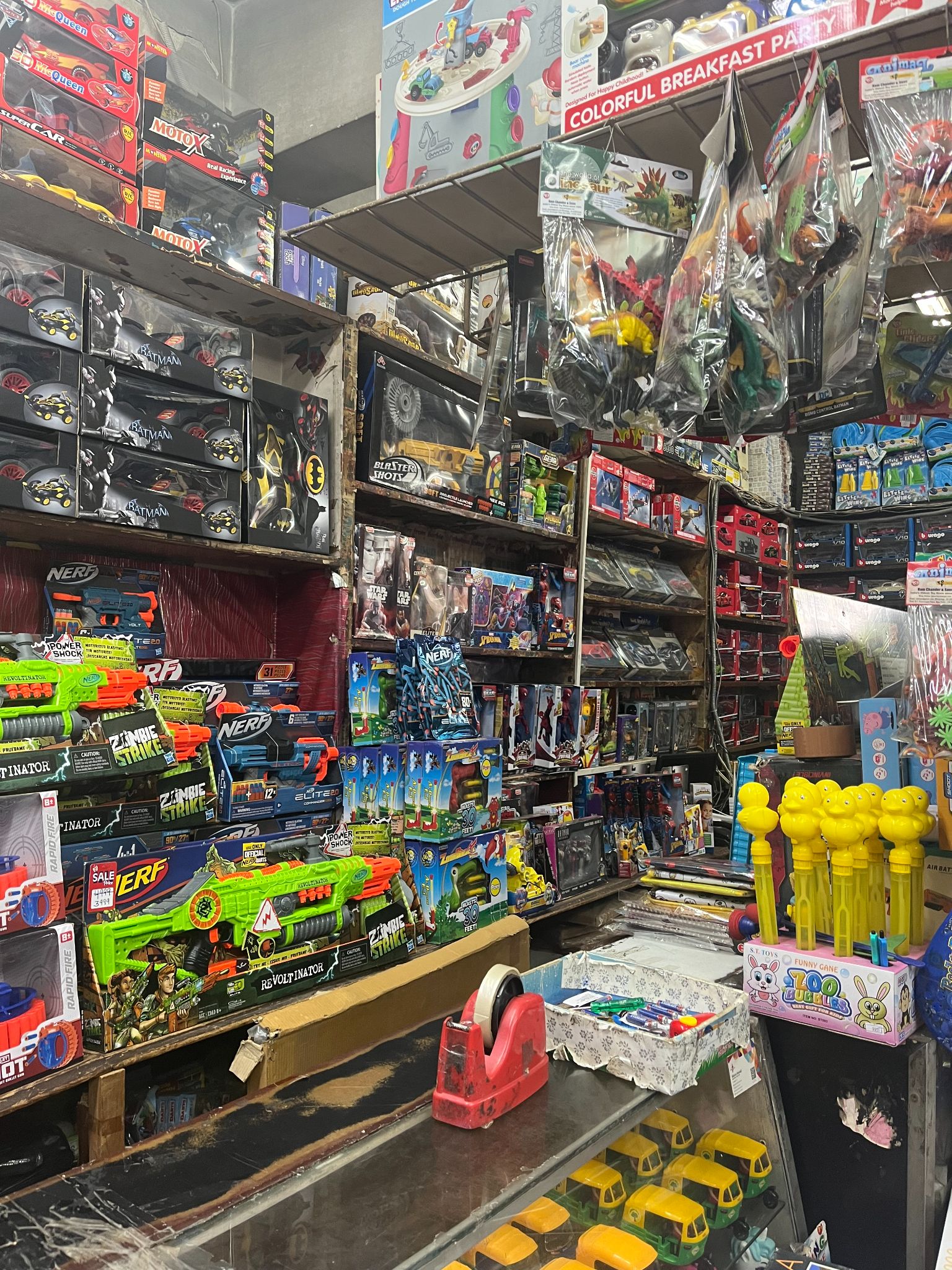Ram Chander & Sons: Exploring Nostalgia and Novelty at India’s Oldest Toy Shop
- enrouteI
- August 18, 2023

Toys are commonly regarded as integral components of a child’s existence, contributing significantly to the shaping of their personality and character. India has a rich legacy of toys, right from the time of the Harrapan civilization (Chawla & Patel, 2017) down to modern-day electronic toys. Fond memories of playing with toys are a universal thread that runs through every child’s early years. To explore this bequest of toys in India, one must wonder- “Where is India’s oldest toy shop?” In the heart of Delhi’s bustling Connaught Place, a timeless haven of wonder and delight awaits: Ram Chander & Sons, India’s oldest and most admired toy shop.
As a cherished landmark that has witnessed the passing of decades, the shop stands as a testament to the enduring charm of play and the evolving tapestry of India’s cultural landscape. I had the opportunity to visit the toy shop and interact with Mr. Satish Sundra, the current owner, who provided me with valuable insights into how Ram Chander & Sons has deftly navigated the currents of time, offering insights into the evolving nature of the toy industry while preserving the irreplaceable magic of cherished memories since 1890 and becoming an integral part of the history of Delhi.
Mr. Sundra is an alumnus of Cambridge University and St. Stephens, University of Delhi as a scholar of History. An elderly gentleman, he is bursting with vitality and humor. He carries an arsenal of jokes, adding laughter to every interaction. Wise and knowledgeable, his insights reflect a life well-lived. I started by asking him about the founding of Ram Chander & Sons and what inspired his family to create this particular business and how the toy shop came about in Delhi’s Connaught place, to which he gave a detailed answer in the most captivating manner.
He informed me that the company was started in 1890, by his great-grandfather, Seth Chunnilal, who decided to open a toy shop in 110, Alexander Road Ambala Cantonment. This makes this shop the oldest toy shop in India still functioning. This was the period when Marwari families were migrating from Rajasthan to the eastern parts of the country. It can only be speculated as to what was the particular reason for opening a toy shop, one possible explanation might be that Mr. Chuunilal was money-strapped and had a brood to take care of so a toy shop must have been a cheaper alternative.
His father migrated to Kasauli, Himachal Pradesh in 1928-1929 and opened up a branch of the shop there and another Connaught Place, Delhi. in 1935-36. In due course, his father’s brother opened his own branches. In the late 1930s, his uncle wanted a separation and his father being a docile man caved in. This was when the Delhi shop in Connaught Place was just opened, his father was now impecunious with a wife and 2 children.

(The Shop | picture by Shambhavi Sharma | August 2023)
But fortunately, Connaught Place was an elite market in the 1930s as the British were the primary crowd. His father tapped into this gentry as clientele of his shop and slowly but steadily grew his business. British had a passion for shops and they recommended their preferred shops to others as well, Ram Chander & Sons was one such endorsed shop in Delhi. In the same class were the various royal families of India, the artificial anglicized royals. They started patronizing his father’s shops for his high moral values. The royalty of Jaipur, Faridkot, Baroda, and Pataudi all used to be the customers of this toy shop. The royals were very affectionate and used to come and converse with his father while sitting on the ground. Famous personalities like M.F Hussain also used to stop by the shop in Delhi on a regular basis. Ram Chander & Sons was thus catering to the creme de la creme of Indian society.
Till the early 1960s this continued but gradually the Anglo-Indians and British started migrating back to Europe post-Indian independence. By 1971, the privy purses (fixed annual payments provided to the former rulers to help them maintain their lifestyles) were abolished and the royal families started diminishing. Therefore, Ram Chander & Sons of the 1980s had to meet the demand of locals of Delhi and beyond and not just the elite constabulary. But now, fortunately, the Indians were coming out of their shells, getting money, and increasing their purchasing power.
The government banned the import of toys in the coming years in the hope that the Indian toy industry would come up, this however was not the result. In 1984, the import was allowed again with several limitations. This was when Mr. Satish’s eldest brother started traveling to China to bring back toy parts and assemble them here in India, this venture was unfortunately not that successful. All suppliers were rogue and unreliable. By the time India opened the doors of commerce to India again, China had become the chief exporter of toys, they used to study trends in different countries and manufacture goods accordingly. Cheap toys had begun to be made and sold. Mr. Satish, however, did not want to compromise on quality. This was an arduous task as research and expense in the toy sector are rudimentary in India and we do not have a center of study for toys that are present in countries like China, France, Germany, and England which help in the RnD of toys.
Mr. Satish also informed me that he used to publish a catalog of toys for children under the age of 4. He is totally dedicated to his industry, his people, and in his words, the “official babysitter of this shop (at Connaught Place)”. He said “that we learn a lot of things from children. therefore, we produce toys that suit them. Without caring about the investment and money. Toys are meant for the biological, mental, and physical development of children, toys are things that enable learning play a child is playing.”
when he took over the shop in 1959 he was, in his own words, a “brown sahib” who hated coming to this chair. He wanted to join civil service as an IFS. But slowly, went on learning and grew to admire and attached his job of continuing the legacy of the oldest toy shop in India.
I inquired him about the kind of toys that the Delhi shop used to have in its early days. He answered that the finest collections from Europe and from America were available, many of which are now considered collectibles. Some of these included, dolls that could walk and talk, mini bricks, and toys meant for playing but also for educational purposes such as engineering sets, chemistry sets, construction sets other themed toys. Even swanky Chinese toys were available. He believes that these toys were meant for building personality and for storage.
I wondered how he balances maintaining the historic aspect of the shop and being part of the history of Delhi with modern retail demands, he replied that his children want to modernize the store but he believes that customers feel more comfortable in the present climate of the shop. He said, “As long as I am alive I shall preserve the vintage and antique value of the shop, many of the material is still from the date the shop was started.”
When asked about his future plans for Ram Chander & Sons he very frankly answered “I have no plans, I am working here for nearly 70 years, I look after my customers will love and affection and I get it back. Any changes that have to be made will be up to my son and daughter-in-law, whatever they want to do, they can do, but as long as I am alive, they won’t make any changes”
Talking about the impact of the pandemic on his business, he said that the shop was closed, but a small store at home was opened and people would come and pick up toys. He even made delivery arrangements for toys all over Delhi. According to him, he was losing money in delivery but maintaining customers.
I asked him about the most fulfilling aspect of continuing the legacy of the shop. He very lovingly responded that the reactions from the children who come to the shop at Connaught Place and refer to him as dadu and nanu (grandfather) and other such silent moments motivate him. His strong inherited family values, coming from a joint family, act as an important aspect in this regard as well.
Ending the interview I asked him about some advice he would give to the coming generations he replied “Parents should buy toys that have some educational clauses. All parents should have a time of day,30-45 minutes, where they spend time with their children and religiously play games that children enjoy, whether it is ludo or snake and ladder. (Parents should) listen to the child’s problems. Finally, there should be a level of friendship between a child’s parents. And (children should) respect value inherited from ancestors.”

( picture by Shambhavi Sharma | August 2023)
I was immensely inspired by the enchanting narrative of Ram Chander & Sons, the convergence of nostalgia and novelty encapsulates not just the evolution of the oldest toy shop, but the very essence of human connection and imagination. This venerable establishment stands as a testament to the enduring power of play and the delicate balance between tradition and innovation. We are reminded that toys are not mere objects; they are vessels of memories and boundless creativity. Ram Chander & Sons continue to be a bridge between generations, inviting all to relive the joys of childhood and discover the timeless magic that resides within its walls and has reserved a place in the cultural consciousness and history of Delhi.

(picture by Shambhavi Sharma | August 2023)
REFERENCES:
- Chawla Suruchika, Patel Ambika. “Terracotta Toy Artefacts of Harappan Culture: A Medium of Learning for Children” Heritage: Journal of Multidisciplinary Studies in Archaeology 5 (2017): 331‐342. http://www.heritageuniversityofkerala.com/JournalPDF/Volume5/20.pdf
Delhi, Delhi history, Connaught place

























